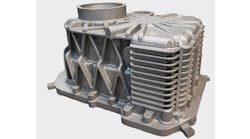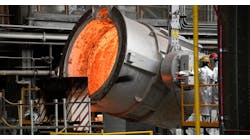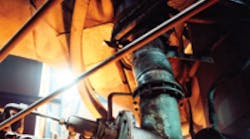Oxygen Technologies to Reduce Coke Usage, Alloying Costs and Waste Generation
The APCOS oxy-fuel burner uses natural gas, substituting heat energy supplied by foundry coke, and reducing coke consumption by up to 40%.
Since its introduction over 200 years ago, numerous improvements have been made to cupola furnaces and the cupola melting process, driving it toward better environmental performance, increased efficiency, and a more flexible operation. One of the most significant improvements is the implementation of oxygen-enriched blast air, which has been in practice since the 1930s.
Enrichment can be accomplished several ways, including diffuser enrichment in the air main and direct tuyere injection. In the early 1960s, Air Products introduced its modified tuyere injection method, which it has installed at over 100 foundries around the world.
The reasons foundries use oxygen enrichment are not complicated. Blast air normally contains 78% nitrogen and 21% oxygen, with the balance being other inert gases. Coke reacts with the oxygen in the blast air, creating heat that melts the charge material. However, the nitrogen representing more than 75% of the volume contributes nothing to the combustion reaction. In fact, nitrogen in the blast air reduces the overall efficiency in the cupola since it takes heat away from the melting process and is exhausted through the flue. By implementing oxygen enriched air, as the oxygen percentage increases, the percentage of nitrogen decreases, the flame temperature and available heat increase, and the heat transfer rate increases, all leading to a much more efficient cupola.
Foundries typically use oxygen enrichment levels of 1-4%, which increases total oxygen to 22-25%. Some foundries use “super-enrichment,” enriching their cupolas beyond 10%. The flexibility of adjusting enrichment levels allows the cupola operator to control the melt rate (up or down), decrease the amount of time required to heat the cupola after it has been offline, and replace coke given the increase in available heat. One application of oxygen that is particularly attractive in current market conditions is the use of higher oxygen enrichment levels to reduce coke usage at the same production rate. Since the price of coke has climbed significantly in recent years, the cost of oxygen often can be justified by the savings in lower coke usage.
In addition to oxygen enrichment, oxygen-natural gas (oxy-fuel) burners can be used to add energy to the melt zone of the cupola, thus further decreasing coke consumption, increasing operating flexibility, and further improving the overall efficiency of the operation.
Oxy-Fuel Innovations
In the early 1990s, Air Products introduced its patented APCOSTM (Air Products Cupola Oxy-fuel System) oxy-fuel burner for cupolas. APCOS allows simultaneous injection of natural gas, oxygen, solids and metallurgical powders through the cupola tuyeres. At the time of introduction, there were three main objectives desired using APCOS: increased fuel efficiency through the reduction of coke consumption; the ability to increase and decrease melt rate quickly; and the ability to inject solid materials without the associated cooling effect. These objectives remain the same today, however now the focus is on increasing the efficiency of the cupola and decreasing the overall cost of operation. Of utmost concern is the increasing cost of foundry coke coupled with declining coke quality and limited availability.
Summary of results that could be achieved with the APCOSTM oxy-fuel burner system.
The APCOS oxy-fuel burner uses natural gas as its fuel, substituting heat energy supplied by foundry coke. Natural gas is one of the most abundant fossil fuels in the U.S., the distribution system is well established, and the current price is low compared to foundry coke. In fact, the price of coke is four times that of natural gas in some markets (evaluated on a $/MMBtu basis). Foundries that have used this technology have been able to reduce coke consumption by up to 40%. This makes APCOS a very attractive option by providing significant savings and quick paybacks.
Natural gas also burns much cleaner than coke, greatly reducing particulate matter and other harmful emissions (e.g., SO2, NOx, etc.). In some cases, CO2 emissions were reduced by 20% with the APCOS technology. Tighter environmental regulations make it even more important to find a coke substitute.
Another characteristic of the APCOS system is the ability to inject waste dust and metallurgical powders (alloying materials) into the melt zone. Injecting solid particles (like dust) into the cupola is not a new concept. An English patent from 1831 describes the addition of coal and additives to a blast furnace, and injection has also been used to add materials such as silicon, cupola ash, coal dust and sweepings. In most cases, it was necessary to blow-in the material periodically because continuous injection caused operational problems by cooling the tuyere. Injecting these materials in the presence of an oxy-fuel burner eliminates the cooling effect and enhances alloy pick-up. Further, waste material can be injected, thus reducing the overall waste that a foundry generates.
Finally, the system is very flexible. The oxy-fuel burners are equipped with supersonic oxygen nozzles. This allows the foundry to shut off the natural gas and still be able to enrich through the tuyeres. Also, the burners are designed to be installed and removed easily if maintenance is needed on the tuyeres.









